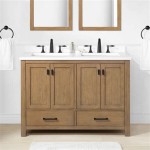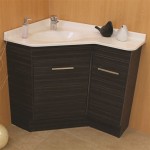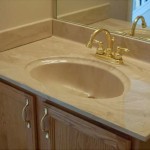Maximizing Space: Bathroom Sinks for Small Bathrooms
The modern bathroom, even when limited in square footage, demands functionality and aesthetic appeal. Choosing the right bathroom sink is paramount in achieving both, especially when dealing with a compact space. A well-selected sink can transform a cramped bathroom into an efficient and visually pleasing area, enhancing the overall usability and perceived spaciousness. This article explores the various types of bathroom sinks suitable for small bathrooms, highlighting their features, benefits, and considerations to facilitate informed decision-making.
Understanding Space Limitations and Sink Considerations
Before delving into specific sink types, it is crucial to accurately assess the bathroom's dimensions and layout. Measure the available wall space, the distance between fixtures, and the door swing radius. These measurements will dictate the maximum sink size and the most suitable mounting options. Ignoring these constraints can lead to wasted space, restricted movement, and a visually cluttered environment. Furthermore, the location of existing plumbing lines is a critical factor. Relocating plumbing can be expensive and time-consuming; therefore, selecting a sink that aligns with the existing plumbing infrastructure is often the most practical and cost-effective solution.
Beyond spatial considerations, the user's lifestyle and preferences should also play a role in the selection process. A single individual might require a significantly smaller sink than a couple sharing the same bathroom. The frequency of bathroom use, the need for counter space, and the desired aesthetic style are all relevant factors. Balancing functionality, aesthetics, and space constraints is key to selecting the optimal sink for a small bathroom.
Types of Bathroom Sinks for Compact Spaces
Several types of bathroom sinks are specifically designed to maximize space efficiency in small bathrooms. Each type offers unique advantages and disadvantages in terms of size, installation, storage, and aesthetic appeal.
Wall-Mounted Sinks
Wall-mounted sinks are a popular choice for small bathrooms due to their space-saving design. These sinks are directly attached to the wall, eliminating the need for a bulky vanity or base cabinet. This allows for more floor space, creating a more open and airy feel. The exposed plumbing can be concealed with a decorative trap or shroud for a more aesthetically pleasing look. Wall-mounted sinks are available in a wide variety of shapes, sizes, and materials, offering design flexibility. However, they typically offer limited or no storage space, which may require alternative storage solutions in the bathroom. Installation requires secure wall mounting, which may necessitate reinforcement of the wall structure, particularly if the sink is heavy.
Pedestal Sinks
Pedestal sinks offer a compromise between the space-saving benefits of wall-mounted sinks and the visual appeal of a more substantial fixture. They consist of a sink basin mounted on a freestanding pedestal, concealing the plumbing lines. While they do not provide storage space in the traditional sense, the pedestal itself adds visual interest and can contribute to the overall aesthetic of the bathroom. Pedestal sinks are available in various styles, from classic to contemporary, making them adaptable to different design schemes. However, similar to wall-mounted sinks, they lack built-in storage, and the pedestal can be difficult to clean around. Installation is relatively straightforward, requiring secure attachment of the basin and pedestal to the floor and wall.
Corner Sinks
Corner sinks are designed to fit snugly into the corner of a bathroom, effectively utilizing otherwise wasted space. This is particularly advantageous in very small or oddly shaped bathrooms where maximizing every inch is crucial. Corner sinks are available in both wall-mounted and pedestal styles, offering further flexibility in terms of design and installation. They are typically smaller than standard sinks, making them ideal for tight spaces. However, the limited size can make them less practical for frequent or intensive use. The corner placement can also present challenges in terms of plumbing connections and accessibility.
Vessel Sinks
Vessel sinks, also known as countertop sinks, sit on top of a vanity or countertop, rather than being recessed within it. This distinct design element can add a touch of modern elegance to a small bathroom. The vanity beneath the vessel sink provides valuable storage space, which is a significant advantage compared to wall-mounted and pedestal sinks. Vessel sinks are available in a wide range of materials, shapes, and sizes, allowing for customization and design expression. However, the height of the vessel sink can make it less accessible for some users, particularly children or individuals with mobility limitations. Careful consideration should be given to the countertop height to ensure comfortable use. Installation requires precise cutting of the countertop to accommodate the plumbing connections.
Vanity Sinks with Compact Cabinets
Vanity sinks are a comprehensive solution for small bathrooms, combining a sink basin with a storage cabinet underneath. These units offer the most significant storage capacity compared to other sink types, providing ample space for toiletries, cleaning supplies, and other bathroom essentials. Compact vanities are specifically designed for small spaces, featuring slim profiles and efficient storage solutions. They are available in a variety of styles and finishes, allowing for integration with the overall bathroom design. However, vanity sinks typically occupy more floor space than wall-mounted, pedestal, or corner sinks. Careful measurement and planning are essential to ensure a proper fit and adequate space for movement. Installation requires connecting the plumbing to the sink and drain, as well as securing the vanity to the wall and floor.
All-in-One Sink and Toilet Combos
In extremely compact bathrooms, an all-in-one sink and toilet combo can be a revolutionary space-saving solution. These units integrate a small sink directly above the toilet tank, allowing the water used for handwashing to fill the toilet tank for the next flush. This closed-loop system conserves water and minimizes the footprint of both fixtures. While these combos are highly functional, they may not be suitable for every user due to their unconventional design and potential limitations in sink size and water pressure. The design is very modern, and may not suit more traditional bathroom styles. Installation can be somewhat complex, requiring careful alignment and plumbing connections.
Material Considerations for Bathroom Sinks
The choice of sink material significantly impacts its durability, aesthetic appeal, and maintenance requirements. Common materials for bathroom sinks include:
Ceramic:
Ceramic sinks are a popular choice due to their durability, stain resistance, and affordability. They are available in a wide range of colors and styles, making them versatile for various bathroom designs. Ceramic is also relatively easy to clean and maintain.Porcelain:
Porcelain is a type of ceramic that is fired at higher temperatures, resulting in a more durable and less porous surface. Porcelain sinks are known for their resistance to scratches, stains, and fading. They also have a glossy finish that adds a touch of elegance to the bathroom.Glass:
Glass sinks offer a unique and modern aesthetic. They are available in various colors, shapes, and textures, allowing for design flexibility. Glass sinks are non-porous and easy to clean. However, they can be more prone to chipping or cracking than ceramic or porcelain sinks.Stainless Steel:
Stainless steel sinks are durable, hygienic, and easy to clean. They are a popular choice for modern and minimalist bathrooms. Stainless steel is resistant to rust and corrosion, making it a long-lasting option. However, it can be prone to water spots and scratches.Stone:
Stone sinks, such as granite or marble, offer a luxurious and natural aesthetic. They are durable and unique, with variations in color and veining. Stone sinks require sealing to protect them from stains and water damage. They can also be more expensive than other sink materials.Composite Materials:
Composite sinks are made from a blend of materials, such as acrylic and resin. They offer a combination of durability, affordability, and design flexibility. Composite sinks are available in a wide range of colors and styles, mimicking the look of natural stone.Optimizing Storage in Small Bathrooms with Sink Choices
Storage is often a premium in small bathrooms. The sink choice can either contribute to or detract from available storage space. As previously mentioned, vanity sinks with cabinets offer the most integrated storage solution. Choosing a vanity with drawers, shelves, or a combination of both can maximize storage capacity. Consider vanities with built-in organizers to keep toiletries and other essentials neatly arranged.
For wall-mounted and pedestal sinks, alternative storage solutions are necessary. Wall-mounted shelves can provide open storage for towels, toiletries, and decorative items. Over-the-toilet storage units can utilize vertical space for additional storage. Baskets and containers can be used to organize items on shelves or on the floor.
Mirror cabinets are another effective storage solution for small bathrooms. They provide hidden storage behind the mirror, keeping toiletries and medications out of sight. Corner shelves and floating shelves can also utilize unused space in the bathroom. The key is to maximize vertical space and utilize every available nook and cranny.
In conclusion, selecting the appropriate bathroom sink for a small bathroom requires careful consideration of space constraints, user needs, aesthetic preferences, and storage requirements. By understanding the different types of sinks available and their respective advantages and disadvantages, one can make an informed decision that optimizes both functionality and visual appeal in a compact space.

Vanities For Small Bathrooms

14 Genius Small Bathroom Design Ideas

9 Ways To Make Your Small Bathroom Feel Bigger Delta Faucet Blog

Bathroom Vanity Ideas The Home Depot

10 Small Powder Room Vanity Ideas You And Your Guests Will Both Love

16 Small Bathroom Vanities 24 Inches Under Kelley Nan

8 Small Bathroom Sinks That Will Make A Big Impact Architectural Digest

R2 Bathrooms Wash Basins Wc S Bathroom Sinks Toilets

35 Best Bathroom Sinks Of 2024 Top Picks

Bathroom Sink Ideas For Small Spaces Hunker
Related Posts







